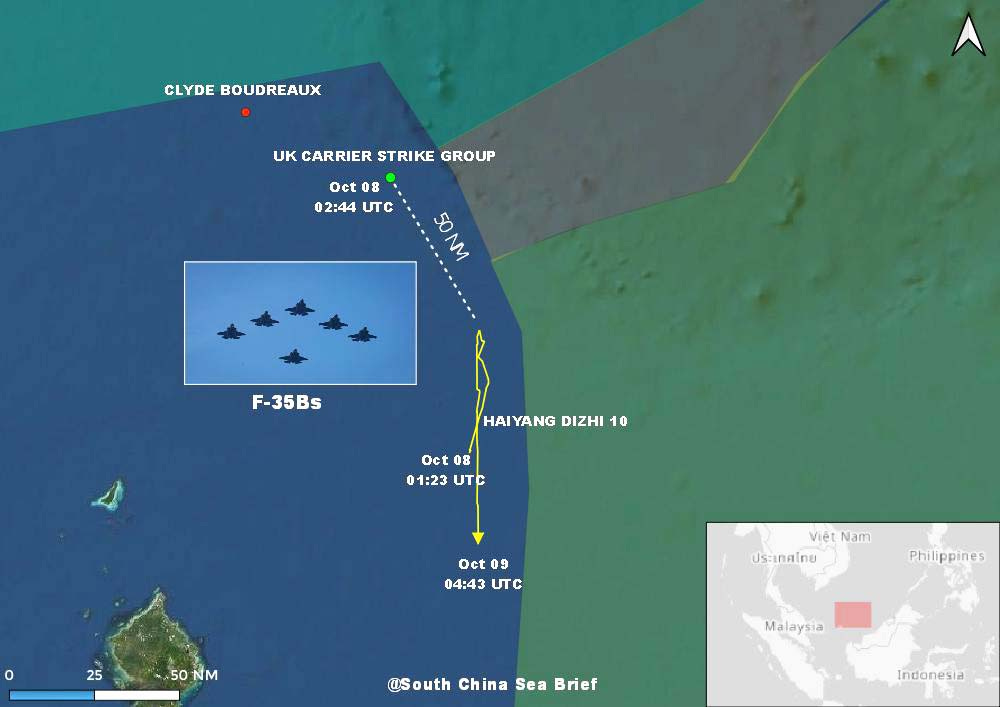South China Sea Brief: October 09, 2021
Ship-tracking data showed the Chinese vessel made abnormal movements, and its speeds abruptly changed throughout the day. This suggests its operation was affected by the presence of the U.K Carrier Strike Group.
1. Aircraft carriers
After entering the South China Sea on October 04, the Carl Vinson Carrier Strike Group left the sea on October 08 through Malacca Strait.
Meanwhile, the UK Carrier Strike Group was spotted operating in the Natuna Sea, where Chinese survey vessel Haiyang Dizhi 10 has been surveying since late August.
The distance between them was about 50 to 80 nautical miles. Interestingly, images released by U.S. Navy showed F-35Bs conducting training missions in the area on October 08.
Ship-tracking data showed the Chinese vessel made abnormal movements, and its speeds abruptly changed throughout the day.
This suggests its operation was affected by the presence of the U.K Carrier Strike Group.
I would not be surprised if there are reports on Chinese warships in the Natuna Sea in the coming days.
Different from the Carl Vinson Strike Group in early September, this time, the armada consists of warships from the U.K, U.S, Netherlands, Japan, Canada, Australia, and New Zealand.
Malaysian and Singapore Drill with U.K., Australia and New Zealand in Bersama Gold 2021 - USNI News
2. USS Connecticut (SSN 22)
Statement regarding USS Connecticut (SSN 22) - U.S. Pacific Fleet
PEARL HARBOR, Hawaii – The Seawolf-class fast-attack submarine USS Connecticut (SSN 22) struck an object while submerged on the afternoon of Oct. 2, while operating in international waters in the Indo-Pacific region. The safety of the crew remains the Navy’s top priority. There are no life threatening injuries.
The submarine remains in a safe and stable condition. USS Connecticut’s nuclear propulsion plant and spaces were not affected and remain fully operational. The extent of damage to the remainder of the submarine is being assessed. The U.S. Navy has not requested assistance. The incident will be investigated.
While the exact location is unclear, many military activities played out in the South China Sea when the U.S. sub got hit on October 02. China sent record-breaking forces of military aircraft to the southwest of Taiwan while three aircraft carrier strike groups conducting exercises in waters east of the Bashi Chanel.
According to The Washington Post
The Navy official said it is believed the vessel could have collided with an inanimate object, such as a submerged shipwreck or shipping container.
…
It is not believed that China caused the collision, the Navy official said. The Connecticut was monitored by other U.S. vessels in the region as it moved to Guam, the official added.
Unfortunately, the incident happened weeks after AUKUS was announced. One of the main concerns from some Southeast Asian nations over the initiative is that it would make the South China Sea more crowded, thus, increasing the odds of either collisions or nuclear accidents in the region.
The recent accident of USS Connecticut – a nuclear-powered submarine will amplify such concerns, which may benefit China, who has protested AUKUS. As expected, Beijing is using the accident to promote its narrative.
TASS News Agency: According to the US Navy statement, on October 2, US Navy nuclear-powered submarine USS Connecticut was damaged after it struck an unknown object while submerged in the waters of the Indo-Pacific region. According to media reports, the incident occurred in the waters of the South China Sea. Do you have any comments on this?
Zhao Lijian: We are gravely concerned about the incident. As the party involved, the US should clarify in specific details what happened, including the exact location of the incident, the US side's navigation intention, the details of the incident, the object the submarine struck, whether the collision caused a nuclear leak or damaged local marine environment, etc.
I would also like to stress three points about the incident. First, the US has long been making trouble in the South China Sea in the name of "freedom of navigation", which poses a grave threat and major risks for regional peace and stability. This is the root cause of this incident. Second, the US deliberately stalled and concealed the specifics of the incident without transparency and due responsibility. China and other countries surrounding the South China Sea cannot help but ask what truly happened and what the US intention is. Third, we can also see the following from this incident. The US and the UK recently decided to conduct nuclear submarine cooperation with Australia, a non-nuclear weapon state, and flagrantly proliferate nuclear submarines in the Asia-Pacific. This is bound to create nuclear proliferation risks, spark an arms race and undermine efforts to establish a Southeast Asia nuclear-free-zone. The odds of a nuclear incident will also increase dramatically. The US should abandon the obsolete Cold War zero-sum mentality and narrow geopolitical notions, and stop such erroneous practice that undermine regional peace, stability and development.
On the location, I tried to check Sentinel images, but the chance to see a submarine from low-res satellite images is very low.
I saw some interesting moves by warships in a relatively small area on October 03. It may or may not be related. I don't know and don’t state anything! Just put it here for anyone who wants to check!
Here's what we can gather about the US nuclear attack submarine collision in the South China Sea - ABC News
USS Connecticut has arrived safely on Guam after mishap in South China Sea - The Guam Daily Post





